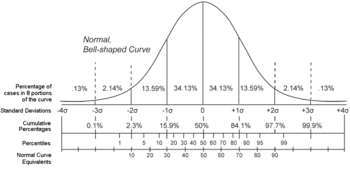Percentile rank
The percentile rank of a score is the percentage of scores in its frequency distribution that are equal to or lower than it. For example, a test score that is greater than or equal to 75% of the scores of people taking the test is said to be at the 75th percentile rank.
Percentile ranks are commonly used to clarify the interpretation of scores on standardized tests. For the test theory, the percentile rank of a raw score is interpreted as the percentages of examinees in the norm group who scored at or below the score of interest.[1][2]
Percentile ranks are not on an equal-interval scale; that is, the difference between any two scores is not the same between any other two scores whose difference in percentile ranks is the same. For example, 50 − 25 = 25 is not the same distance as 60 − 35 = 25 because of the bell-curve shape of the distribution. Some percentile ranks are closer to some than others. Percentile rank 30 is closer on the bell curve to 40 than it is to 20.
The mathematical formula is
where cℓ is the count of all scores less than the score of interest, ƒi is the frequency of the score of interest, and N is the number of examinees in the sample. If the distribution is normally distributed, the percentile rank can be inferred from the standard score.

See also
References
- ↑ Crocker, L., & Algina, J. (1986). Introduction to classical and modern test theory. New York: Harcourt Brace Jovanovich College Publishers. ISBN 0-03-061634-4
- ↑ Schultzkie, Lisa. "Percentiles and More Quartiles". Oswego City School District Regents Exam Prep Center. Retrieved 26 November 2013.
| ||||||||||||||||||||||||||||||||||||||||||||||||||||||||||||||||||||||||||||||||||||||||||||||||||||||||||||||||||||||||||||||||||||||||||||||||||||||||||||||||||||||||||||||||||||||||||||||||||||||||||||||||||||||
